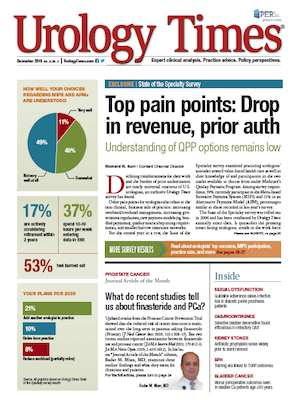Publication
Article
Urology Times Journal
How MIPS Cost category changes will affect urologists
Author(s):
"On Nov. 1, 2019, CMS published a final rule making important changes to the 2020 Quality Payment Program (Merit-based incentive Payment System [MIPS] and alternative payment models). Among the most significant are changes to the MIPS Cost Category: changes in the way patients are attributed to physicians, changes in the way the cost measures are calculated, and the addition of new episode-based cost measures," writes Robert A. Dowling, MD.
metamorworks - stock.adobe.com


On Nov. 1, 2019, the Centers for Medicare & Medicaid Services (CMS) published a final rule making important changes to the 2020 Quality Payment Program (Merit-based incentive Payment System [MIPS] and alternative payment models [APMs]). Among the most significant are changes to the MIPS Cost Category: changes in the way patients are attributed to physicians, changes in the way the cost measures are calculated, and the addition of new episode-based cost measures.
In this article, I will highlight those changes that are expected to affect urology practices and physicians.
Category weight. The statute underlying the implementation of MIPS (MACRA) requires that by performance year 6, the weights of the Quality and Cost categories be 30% each, and past rules have outlined a schedule in 2020 (performance year 4) of 40% for Quality and 20% for Cost. During the public comment period, many physicians communicated their concerns about the Cost category; chiefly, the lack of real-time access to cost data. In response, CMS kept the weight of the categories the same for 2020 as 2019: 45% for Quality and 15% for Cost.
Also by Dr. Dowling: How recent legislation has affected payment for lab tests
Total Per Capita Cost (TPCC) Measure. This long-standing measure of Medicare patients’ Part A and B costs has been significantly revamped in response to concerns that it assigned costs to clinicians over which the physician has no control, it did not properly identify primary care relationships, and the risk adjustment methodology was based on risk factors 1 year in arrears.
In the revised measure, patients will be attributed preferentially to primary care physicians based on claims for primary care services-not evaluation and management CPT codes shared by all specialists. In addition, patients will not be attributed to specialists with a high frequency of non-primary care services, like surgery. Under the revised measure specifications, CMS estimates that no urologists will be attributed patients for this measure beginning in 2020-a significant departure from past years.
Finally, CMS will now determine risk scores for a beneficiary using diagnosis data (from claims) from the previous 12 months rather than the previous calendar year, which should better represent the current health status of patients. Again, under the new attribution rules and specialty exclusions, urologists in most practices will not meet the 20-case minimum for this measure.
Medicare Spending Per Beneficiary Clinician (MSPBC) Measure. This measure of inpatient episode costs has also been redesigned in response to feedback that the current methodology could assign costs to physicians performing the most expensive care instead of those directing the overall care. Under the new specifications, inpatient medical episodes will be attributed separately from inpatient surgical episodes. Urologists would likely be attributed patients who, for example, were admitted for a cystectomy. Instead of including all Part A and B costs, the newly designed measure excludes costs unrelated to principal diagnosis-related group. The case minimum for this measure is 35; because attribution is at the practice level, urologists are likely to be measured.
Next: Episode-based Cost MeasuresEpisode-based Cost Measures. CMS has finalized the addition of 10 new episode-based measures, including one that is likely to impact most urologists: Renal or Ureteral Stone Surgical Treatment. Under this measure, any of six surgical procedures (percutaneous nephrolithotripsy [two codes], ureteroscopy [three codes], or extracorporeal shock wave lithotripsy [one code]) in any care setting will trigger an episode. Costs for the episode are included or excluded from the episode based on a complex set of rules constructed with input from urologists. The average, risk-adjusted episode costs attributed to each clinician is then compared to benchmarks and a “score” is generated for this measure (lower costs=better score).
A clinician’s score relative to peers then determines performance on this measure in MIPS, just like the other measures in this category (TPCC, MSPBC). The case minimum for this measure is 10, and the score is aggregated at the practice level. Most urologists are expected to be impacted.
Read: Losing patients to follow-up? Here’s what you can do
Putting it all together: All of the applicable measures within the Cost category contribute equally to the category score, which in turn contributes 15% of the total MIPS score. For example, if a practice had no patients attributed for the TPCC, a score of 5/10 for MSPBC, and a score of 7/10 for episode-based cost measures, their Cost category score would be 0.6 X 15 points=9 points.
Bottom line: The 2020 Quality Payment Program Final Rule is the next step in an attempt to hold providers accountable for costs in the Medicare program, and this year’s changes address some of the concerns raised by earlier versions of the program-including an episode measure that should be broadly applicable to urology and changes to measures that inappropriately assigned accountability to urologists.
We want to hear from you! Send your comments to urology_times@mmhgroup.com





























